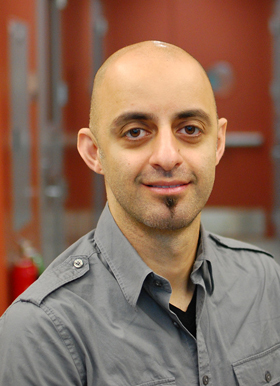
Moe R. Mahjoub, PhD
Associate Professor of Medicine, Division of Nephrology
- Phone: 314-362-5681
- Email: mmahjoub@nospam.wustl.edu
Additional Titles
- Assistant Professor, Cell Biology and Physiology
Related Links
Mailing Address
Division of Nephrology
-
Mailing Address:
660 S. Euclid Ave., CB 8126
St. Louis, MO 63110
Research Interests
Cilia, centrosome, microtubule cytoskeleton, ciliopathies, cystic kidney disease, primary cilia dyskinesia, cancer.
The focus of research in our laboratory is to understand how two essential organelles, the centrosome and cilium, organize signaling pathways that control diverse cellular functions. These highly conserved organelles act as signaling hubs that regulate various aspects of cell-cycle progression, cell differentiation, polarity, and migration. Defects in the structure and function of centrosomes and cilia lead to a range of human disease phenotypes known collectively as “Ciliopathies”. These include developmental defects such as polycystic kidney disease, nephronophthisis, polydactyly, infertility, hydrocephalus and cancer, as well as neurocognitive defects including mental retardation and dyslexia. We employ genomic, proteomic, biochemical and cell biological methods to delineate the regulation of centrosome-cilium assembly and function. Current experiments are focused on (1) determining the molecular mechanisms of protein trafficking and localization to cilia; (2) proteomic approaches to identify regulatory proteins involved in centrosome assembly and duplication; and (3) examining the consequences of abnormal centrosome and cilium function in human disease, with particular emphasis on ciliopathies affecting the kidney, such as polycystic kidney disease, nephronophthisis and cancer.
Publications
Selected Publications
Hoshi M, Wang J, Jain S, Mahjoub MR. Imaging centrosomes and cilia in the mouse kidney. Methods Cell Biol. 2015;127:1-17.
Mahjoub MR and Tsou MF. (2013). The AmAZI1ing roles of centriolar satellites during development. PLoS Genetics. 9(12):e1004070.
Mahjoub MR. (2013). The importance of a single primary cilium. Organogenesis. 9(2).
Mahjoub MR and Stearns T. (2012). Supernumerary centrosomes nucleate extra cilia and compromise primary cilium signaling. Current Biology, 22(17):1628-34.
Park KS, Martelotto LG, Peifer M, Sos ML, Karnezis AN, Mahjoub MR, Bernard K, Conklin J, Szczepny A, Yuan J, Guo R, Ospina B, Falzon J, Bennett S, Brown TJ, Markovic A, Devereux WL, Ocasio CA, Chen JK, Stearns T, Thomas RK, Dorsch M, Buonamici S, Watkins DN, Peacock CD and Sage J. (2011). A crucial requirement for Hedgehog signaling in small cell lung cancer. Nature Medicine, 17(11):1504-8.
Mahjoub MR, Xie Z and Stearns T. (2010). Cep120 is asymmetrically localized to the daughter centriole and is essential for centriole assembly. J Cell Biol. 191(2):331-46.
Parker JD, Hilton LK, Diener DR, Rasi MQ, Mahjoub MR, Rosenbaum JL and Quarmby LM. (2010). Centrioles are freed from cilia by severing prior to mitosis. Cytoskeleton 67(7):425-30.
Mahjoub MR, Trapp ML and Quarmby LM. (2005). NIMA-related kinases defective in murine models of polycystic kidney diseases localize to primary cilia and centrosomes. J. Am. Soc. Nephrol. 16(12): 3485-3489.
Quarmby LM and Mahjoub MR (2005). Caught Nek-ing: Cilia and centrioles. J Cell Sci 118: 5161-5169.
Mahjoub MR, Rasi QM and Quarmby LM (2004). A NIMA-related kinase, Fa2p, localizes to a novel site in the proximal cilia of Chlamydomonas and mouse kidney cells. Mol Biol Cell. 15(11):5172-86.
Blacque OE, Reardon MJ, Li C, McCarthy J, Mahjoub MR, Ansley SJ, Badano JL, Mah AK, Beales PL, Davidson WS, Johnsen RC, Audeh M, Plasterk RH, Baillie DL, Katsanis N, Quarmby LM, Wicks SR and Leroux MR (2004). Loss of C. elegans BBS-7 and BBS-8 protein function results in cilia defects and compromised intraflagellar transport. Genes Dev. 18: 1630-42.
Mahjoub MR, Montpetit B, Zhao L, Finst RJ, Goh B, Kim AC and Quarmby LM (2002). The FA2 gene of Chlamydomonas encodes a NIMA family kinase with roles in cell cycle progression and microtubule severing during deflagellation. J. Cell Sci. 115, 1759-1768.